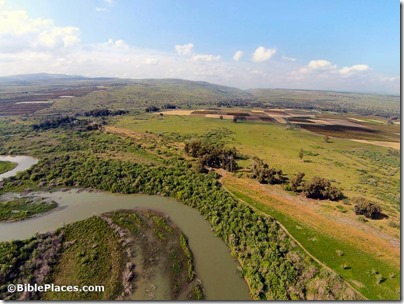For thirty years now, Rami Arav has led excavations at the site of et-Tell. Since the beginning, he has identified the ruins with the New Testament site of Bethsaida. This identification was quickly adopted by Israeli road sign makers, and most popular literature today calls the site “Bethsaida.” Arav has argued strenuously that his site is Bethsaida, and the titles of all of the excavation reports begin with “Bethsaida.” The problem is that as excavations progressed, the site turned out to be primarily an Iron Age city, with little remains from the first century AD.
That has bothered a number of scholars for several decades now, and the site of el-Araj has been suggested as the true site of the fishing village where several of Jesus’s disciples lived. This past summer, Mordechai Aviam began excavations to determine if el-Araj is a more suitable candidate for Bethsaida.
A preliminary summary posted online gives a bit of the background as well as brief descriptions of the two excavation areas. Of the western area, Aviam writes:
Underneath the Crusader level we discovered remains of a dwelling dated to the late Byzantine-early Islamic period. An unusual large bronze jar was uncovered, which has been sent to the laboratory for conservation. Coins and pottery dating from the 6th-8th centuries were uncovered on the floors. The most surprising find was a group of gilded glass tesserae, which are used in the construction of wall mosaics. These type of tesserae are typical to large and important churches. Which means, even before finding the church itself, it is possible to suggest that in the Byzantine period, el-Araj was identified as a holy place, most likely Bethsaida. One of the walls contains a large, reused, monolithic, limestone pillar, and nearby, outside of the excavation area, there is another limestone double “heart-shaped” pillar, which are both typical to late Roman Jewish synagogues in Galilee.
Concerning the period of interest, he summarizes:
Both areas yielded a large number of typical early Roman pottery. As of yet, structures from the early Roman period have not been uncovered.
He concludes:
After this initial season of excavation, our primary conclusions are: 1) the site of el-Araj was most likely identified as Bethsaida during the Byzantine period, and a church, probably a pilgrim monastery was erected at the site. 2) The site of el-Araj was inhabited during the early Roman period; therefore, it remains a good candidate for the identification of Bethsaida. 3) We will continue to excavate el-Araj in the coming years.
I think he’s on solid ground on point #3. The other two points are clearly premature. While making these claims may help the team raise money and support, scholarship is not well served by making such bold assertions so early in the process. This in fact is what troubles many about Arav’s identification. He made the claim early on and now it’s not easy to admit failure. If Aviam’s site is indeed Bethsaida, he can take his time to collect the evidence that will make a compelling case.
A two-minute video (mostly in Hebrew) provides footage of excavations at both candidates for Bethsaida, with a cameo by Indiana. Nyack College has a couple of dozen photos on its Facebook page.
I’m told that donations would be appreciated for next year’s excavations. You should be able to do that through the Center for Holy Lands Studies.

2 thoughts on “New Excavations at el-Araj, Possible Bethsaida”
I participated in a two-week dig at et-Tell in 2012 under Rami Arav. From my brief time there, we did find quite a bit of Hellenistic material and some Roman. They have also found some evidence of a Jewish presence (limestone vessels, Herodian lamps, some coins) from the Roman period. As I see it there are three problems.
1) The distance from the Sea of Galilee makes it hard to see it functioning as a fishing village. But, there is geological evidence of that the location certainly still had easy access to the Jordan River and the Sea. (Personally, I joke that even though Peter is said to be from Bethsaida, we find him in Capernaum at the house of his mother-in-law, because he had looked for a good Jewish girl who lived closer to the Sea!)
2) If it is the Bethsaida of the NT, one would expect to find more evidence of a Jewish presence during the Roman period. This may just be a problem of looking in the wrong place. There is a lot of the site yet to be explored, and perhaps it shouldn't be expected to find a strong Jewish presence in the highest (and hence, aristocratic) part of the mound that has been excavated. (It is not surprising to find the significant Iron Age presence at the top of the mound.)
3) According to Josephus, Herod Philip designated Bethsaida as a "city" and planned for his burial there. If so, it isn't much of a "city" by Roman terms. Almost all basalt… It's not impressive, especially as compared to a place like Susita/Hippos further south on the eastern shore.
I'm wondering, however, if Bethsaida should be regarded as a two-part city, especially after the geological dislocation from the Sea. It makes sense to me that the ancient mound would have served an aristocratic population while a location by the sea would have emerged for the common laborers and fishermen. From what I've been able to determine, a similar situation existed for Hippos/Susita which had a harbor that was about as far away(and there is much more of a hill to climb to get up to Hippos!). Even Gadara had a harbor access which is about 3.5 miles from the city itself.
Mark – I appreciate your insights, especially with your experience. And your comparison with the sites of Hippos and Gadara is quite helpful. What remains is to find ruins that match the textual evidence.